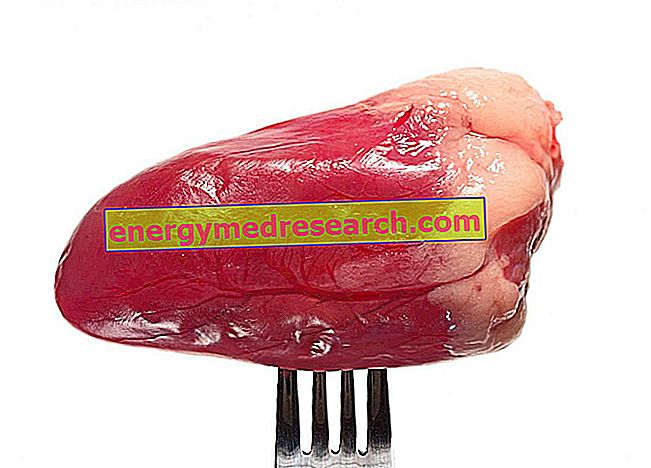Generality
Asiago (in local dialect "pegorin") is a national cheese that has the DOP recognition (Protected Designation of Origin). It takes its name from the homonymous Venetian city of Asiago, located on one of the most famous highlands of Italy.

The first historical traces of the Asiago date back more or less to the year 1000 AD, but it is conceivable that his invention is much older (perhaps prior to the Republic of Venice). In fact, it has been shown that the inhabitants of the Altopiano dei Sette Comuni have practiced pastoralism mainly for dairy purposes since the dawn of time.
Nutritional Features
Asiago is part of the second of the VII fundamental food groups, that of milk and its derivatives.
Its dietary function is to provide proteins rich in essential amino acids, calcium, phosphorus and vitamin B2 (riboflavin).
Asiago is a cheese made from whole or partially skimmed cow's milk; therefore, it contains a fairly high amount of lipids. Not surprisingly, calories come mainly from lipids, followed by peptides and finally by small amounts of carbohydrates. The fatty acids contained in Asiago cheese are mainly saturated, high biological value proteins and simple carbohydrates (lactose).
The fibers are absent and the cholesterol is abundant.
The Asiago saline profile does not differ from the average of the cheeses and is abundant in calcium, phosphorus and sodium.
As far as vitamins are concerned, retinol and equivalents (vitamin E and provitamine A), B2 (riboflavin) and K2 (menaquinones of bacterial origin) are especially present. Vitamin B12 should be abundant.
Due to its energy richness, Asiago does not lend itself to the diet of overweight subjects. Furthermore, due to the exuberance of saturated fatty acids and cholesterol, this cheese should be avoided by people suffering from hypercholesterolemia.
Like most aged cheeses, Asiago also contains considerable amounts of sodium, a decidedly contraindicated aspect in the case of primary arterial hypertension (especially for sodium-sensitive subjects). Furthermore, the abundance of minerals (including phosphorus, potassium and calcium) makes Asiago a food unsuitable for certain types of renal impairment.
Asiago contains small amounts of lactose; therefore, it should not be consumed by the most sensitive intolerant (on the other hand it is a very subjective aspect). There are no traces of gluten and can therefore be contextualized in the celiac diet.
Being a derivative of milk, Asiago is not part of the food allowed in the vegan diet; moreover, the traditional one uses animal rennet (obtained from the calf's stomach), so it should also be excluded from the diet of the vegetarian lacto subjects.
The average portion of Asiago (as a dish) is about 70-120g (250-430kcal).
Gastronomy
Asiago is used as a dish in its own right, an ingredient for elaborate recipes or simply grated on pasta.
The oenological combination varies according to the type:
- Fresh and fat Asiago: sweet white wine.
- Fresh and lean Asiago: dry, white or red wine.
- Seasoned and cooked Asiago: dry red wine.
- Spicy Asiago: old and robust wine.
For information on possible recipes, we recommend that you visit the page: Recipes with Asiago Cheese.
Carasau bread pie with stracchino and Asiago courgettes
X Problems with video playback? Reload from YouTube Go to Video Page Go to Video Recipes Section Watch the video on youtubeAsiago variety
Asiago can also be classified according to seasoning and type.
- Seasoning:
- Asiago Mezzano : about 3-8 months.
- Asiago Vecchio : generally no more than 18 months.
- Asiago Stravecchio : at least two years.
- Types:
- Asiago d'allevo : used as a table cheese or to be grated, it is a semi-cooked paste . It is produced only with cow's milk obtained from two milkings, of which one is skimmed by surfacing, or by a single partially skimmed milking (always by surfacing). Acidity can be natural or induced with ferments. It is dry salted or in light brine. The seasoning is that of a mezzano or an old / old man. The shape is cylindrical with a low heel, straight and with flat faces. It can reach 8-12kg in weight. The height is 9-12cm and the diameter is 30-36cm. It has a smooth and regular crust. The mezzano pasta is compact, with sparse holes and of small or medium size; slightly straw-colored. The taste is sweet. The pasta of the old / old is grainy, with a conchoidal split, with sparse holes and of small or medium size, straw-colored; the flavor is characteristic and fragrant. The asiago d'allevo has a percentage of fat on the dry substance equal to 24%.
- Asiago pressed : used only as a table cheese, it is semi-cooked paste fat . It is produced only with cow's milk from two milkings or just one. Acidity can be natural or induced with ferments. Salting takes place in paste and can be reinforced after pressing. Maturation takes place 20-40 days after manufacture. The shape is cylindrical with straight or slightly convex heights and with flat faces. It can reach 11-15kg in weight. The height is 11-15cm and the diameter is 30-40cm. It has a thin and elastic crust. The pasta is combined with the cut, has a marked and irregular eye, has a white or slightly straw color. The taste is delicate and pleasant. Asiago d'allevo has a fat percentage on the dry substance of not less than 44%.
Production locations
According to the PDO production regulations, asiago is produced on:
- Vicenza and Trento, including provinces.
- Certain municipalities in the province of Padua including: Carmignano di Brenta, S. Pietro in Gù, Grantorto, Gazzo, Piazzola sul Brenta, Villafranca Padovana, Campodoro, Mestrino, Veggiano, Cervarese S. Croce and Rovolon.
- Certain municipalities in the province of Treviso: the delimitation is too complex to be described and would require the use of a map.
Bibliography
- Milk, yogurt, butter and cheese - G. Sicheri - Publisher Ulrico Hoepli Milan - pag 101-102.
- The Vicentine Cuisine: History and Recipes - G. Capnis and A. Capnis Dolcetta - Tarka.



